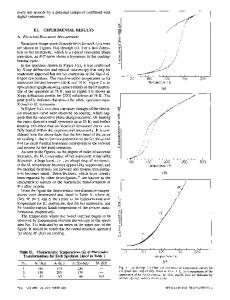Nucleation and growth of bainite crystals in Cu-Zn-AI alloys
- PDF / 1,287,241 Bytes
- 5 Pages / 594 x 774 pts Page_size
- 66 Downloads / 318 Views
I.
BAINITIC TRANSFORMATION IN N O N F E R R O U S A L L O Y S
THE bainitic
transformation is now believed to occur in nonferrous alloys, such as noble metal-base fl-phase alloys. These alloys contain substitutional solute atoms in the matrix lattice, contrary to carbon steels t~,21 which transform bainitically with the movement of interstitial carbon atoms. Hence, the behavior of solute atoms could be different in nonferrous alloys vs carbon steels. The bainite plate with 9R close-packed structure is transformed individually in Cu-Zn, t3-7] Cu-Zn-A1, t8'9] and AgCd tl~ alloys. On the other hand, complex bainitic structures with a and 3'2 phases start to appear from the beginning in Cu-AI t121and Cu-Sn t131alloys. However, in any case, the transformation is thought to proceed with characteristics of both martensitic and diffusion-controlled transformations. Two different interpretations have so far been made on the nucleation and growth of bainite products in nonferrous alloys as well as in carbon steel. The first view [4.7] is that the bainite crystal with supersaturated solute concentration nucleates martensitically, followed by a growth during which the solute concentration is modified to its equilibrium value. In the second, t~41 the bainite with equilibrium solute concentration is thought to precipitate initially and then continue to grow with the diffusion process. The former view seems inconsistent with the fact that the bainite nucleates at a higher temperature than the Ms temperature, and the latter one with a very large shape change t91 accompanying the transformation. In order to clarify these points, several investigators ]4,14-161 have tried to measure directly the compositional change at the nucleation sites. However, these measurements have only amplified the confusion in understanding the transformation mechanism, because they have never taken into consideration the possible compositional change in the matrix prior to the bainite nucleation. |~7,~8,~91
K. TAKEZAWA, Instructor, and S. SATO, Professor Emeritus, are with the Department of Applied Physics, Faculty of Engineering, Hokkaido University, Sapporo 060, Japan. This paper is based on a presentation made in the symposium "International Conference on Bainite" presented at the 1988 World Materials Congress in Chicago, IL, on September 26 and 27, 1988, under the auspices of the ASM INTERNATIONAL Phase Transformations Committee and the TMS Ferrous Metallurgy Committee. METALLURGICAL TRANSACTIONS A
II. SUMMARIZED RESULTS ON THE B A I N I T I C TRANSFORMATION IN Cu-Zn-Al ALLOYS The present authors have performed various investigations on Cu-Zn-A1 shape memory alloys and have accumulated sufficient data by which the mechanism of the bainitic transformation is discussed in detail. Important results are summarized as f o l l o w s , t8'9'17-191 In alloys with low electron concentrations, i.e., the electron atom ratio e / a ~ 1.42, the bainite plate with disordered 9R close-packed structure is observed after an incubation period on heating at moderate
Data Loading...










